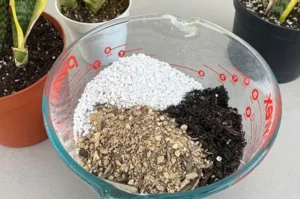Snake plants, also known as Sansevieria or Dracaena trifasciata, are popular houseplants because they’re easy to care for, stylish, and tough. Their upright leaves and low-maintenance nature make them ideal for both beginners and experienced plant lovers. But what happens when temperatures drop? Can snake plants survive cold weather?
In this article, we’ll explore how snake plants react to cold conditions, what temperatures they can tolerate, signs of cold damage, and how to protect them during winter.
Understanding the Natural Habitat of Snake Plants
To understand how snake plants respond to cold, we need to look at where they come from. Snake plants are native to West Africa, where the climate is warm, dry, and sunny. These plants are used to temperatures ranging between 60°F to 85°F (16°C to 29°C). Their natural environment does not experience freezing temperatures.
Because of this, snake plants are not built to handle cold weather for extended periods. But that doesn’t mean they can’t survive at all in chilly conditions. With the right care and precautions, your snake plant can get through the colder months.
What Temperature is Too Cold for Snake Plants?
Snake plants start to struggle when temperatures drop below 50°F (10°C). While short periods of slightly cooler temperatures may not kill the plant, prolonged exposure to cold can cause serious damage. Temperatures below 40°F (4°C) are considered dangerous, and frost or freezing temperatures can kill the plant completely.
Signs Your Snake Plant is Too Cold
If your snake plant is exposed to cold temperatures, it will start showing signs of stress. Some common symptoms of cold damage include:
- Soft or mushy leaves: Cold causes the water in the plant cells to freeze and expand, damaging the cell walls. This leads to soft, squishy leaves.
- Discoloration: You may notice dark patches, yellowing, or browning on the leaves.
- Drooping or collapsing leaves: The plant may lose its firmness and start to fall over.
- Root rot: If the plant is watered too often during cold months, it can develop root rot, especially when the soil stays wet for too long.
If your snake plant shows these symptoms after a cold snap, it’s likely suffering from temperature stress.
How to Protect Snake Plants in Cold Weather
Although snake plants are sensitive to cold, you can take simple steps to keep them safe during winter:
1. Bring Them Indoors
If your snake plant is outdoors and temperatures are expected to fall below 50°F (10°C), bring it inside. Choose a warm room with indirect light. Avoid placing it near windows that get cold drafts or doors that are frequently opened.
2. Avoid Overwatering
Snake plants grow more slowly during winter, and the soil takes longer to dry out. Reduce how often you water the plant. Overwatering in cold weather can lead to root rot.
Tip: Always check that the soil is completely dry before watering again.
3. Use a Room Thermometer
Keep your indoor temperature consistent. Using a room thermometer can help you track whether your space is warm enough for the plant. Aim for a range of 60°F to 80°F (16°C to 27°C).
4. Keep Away From Cold Windows and Heaters
Cold windows can cause sudden temperature drops, and heaters can dry out the air and scorch leaves. Keep your snake plant at a safe distance from both.
5. Use a Heat Mat for Extra Warmth
For plant enthusiasts in very cold regions, a plant heat mat placed under the pot can help keep the soil warm. These mats are especially useful in basements or sunrooms.
Can Snake Plants Be Grown Outdoors in Winter?
In regions with mild winters (such as USDA hardiness zones 9–11), snake plants can survive outdoors all year round. However, in colder climates, they need to be brought indoors or protected during the coldest months.
If you want to keep your snake plant outdoors:
- Use a pot: This makes it easy to move the plant indoors when temperatures fall.
- Provide shelter: Place it near a wall or under a patio roof to block wind and frost.
- Use covers: Frost blankets or plant covers can provide temporary protection during cold nights.
What to Do If Your Snake Plant Has Cold Damage
If your plant has already been exposed to cold, don’t panic. It might still recover if the damage is not too severe.
Here’s what to do:
- Move it to a warm spot: Get the plant out of the cold immediately.
- Hold off on watering: Wait until the soil is completely dry.
- Trim damaged leaves: Use clean scissors to remove mushy or brown parts. This helps the plant focus its energy on new growth.
- Be patient: Snake plants grow slowly, especially in winter. Give it time to recover.
Should You Fertilize Snake Plants in Winter?
No, snake plants don’t need fertilizer during the winter. They go into a resting phase and won’t use the extra nutrients. Fertilizing during cold months can cause salt build-up in the soil, which can harm the plant. Save your feeding routine for spring and summer when the plant begins to grow again.
Final Thoughts
Snake plants are incredibly tough, but they’re not fans of cold weather. These tropical plants prefer warmth and dry conditions. While they can tolerate slightly cool temperatures for short periods, extended exposure to cold or frost can seriously damage or even kill them.
By bringing your plant indoors, reducing watering, and avoiding cold drafts, you can help your snake plant stay healthy through the winter season. With just a little extra care, your snake plant will bounce back when warmer weather returns.






